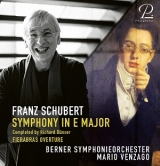Franz Schuberts Symphonie E-Dur D. 729 aus dem Jahre 1821 ist eine von Schuberts unvollendeten Symphonien. Zu dieser Komposition gibt es einen vollständigen Entwurf aller vier Sätze, und die ersten 110 Takte wurden noch von Schubert selbst orchestriert. Der Torso, der sehr schöne Musik enthält, wurde schon 1881 erstmals vom englischen Komponisten John Francis Barnett vervollständigt, dann 1934 von Felix Weingartner und schließlich 1982 vom Schubert-Spezialisten Brian Newbould. Diese letztgenannte Version hat Kevin John Edusei mit den Münchner Symphonikern aufgenommen (siehe unten).
Für Prospero hat das Berner Symphonieorchester unter Mario Venzago eine neue Fassung eingespielt, die der österreichische Komponist Richard Dünser zusammen mit Venzago erstellt hat.
Wie Venzago im Textheft schreibt, hat Dünser seinen Vorschlag aufgegriffen, « die weniger inspirierten Mittelsätze durch fertig zu ergänzende Entwürfe aus dem Todesjahr zu ersetzen. » So wurden das Andante D. 936 und ein Scherzo D. 708 vor das Allegro giusto aus D. 729 eingeschoben, und zum Schluss erklingt ein weiteres Scherzo aus D. 936.
D. 936 ist eine Sammlung von drei Entwürfen für eine Symphonie in D aus dem Jahre 1828. Zwei davon haben also Eingang in diese Rekonstruktion gefunden. D. 708 ist eine Sammlung von Particell-Entwürfen, ebenfalls für eine Symphonie in D (nach 1820), aus der das erste Scherzo der Dünser-Venzago-Fassung stammt. Somit enthält die jetzt als Siebte Symphonie bezeichnete Komposition sechs Sätze mit einer Gesamtspieldauer von 48 Minuten.
Sie passen gut zusammen und werden vom Berner Symphonieorchester mit lyrischem Drive gespielt. Venzago setzt auf das Frische, auf das Impulsive und auf Kontraste, und das bekommt der Musik bestens.
Hervorragend ist auch die Aufnahme der Fierabras-Ouvertüre, mit der die CD beginnt.
Franz Schubert’s Symphony in E major D. 729 from 1821 is one of Schubert’s unfinished symphonies. There is a complete draft of all four movements for this composition, and the first 110 measures were orchestrated by Schubert himself. The torso, which contains very beautiful music, was first completed by the English composer John Francis Barnett as early as 1881, then by Felix Weingartner in 1934, and finally by Schubert specialist Brian Newbould in 1982. This latter version was recorded by Kevin John Edusei with the Munich Symphony Orchestra (see below).
For Prospero, the Bern Symphony Orchestra under Mario Venzago has recorded a new version that Austrian composer Richard Dünser created with Venzago.
As Venzago writes in the text booklet, Dünser took up his suggestion to « replace the less inspired middle movements with ready-to-complete drafts from the year of his death. » Thus the Andante D. 936 and a Scherzo D. 708 were inserted before the Allegro giusto from D. 729, and another Scherzo from D. 936 is heard at the end.
D. 936 is a collection of three sketches for a symphony in D from 1828, so two of them have found their way into this reconstruction. D. 708 is a collection of Particell drafts, also for a symphony in D (after 1820), from which the first scherzo of the Dünser-Venzago version comes. Thus the composition now called the Seventh Symphony contains six movements with a total playing time of 48 minutes.
They fit together well and are played with lyrical drive by the Bern Symphony Orchestra. Venzago goes for the fresh, the impulsive, and the contrasts, and that suits the music just fine.
The recording of the Fierabras Overture, with which the CD begins, is also excellent.
























